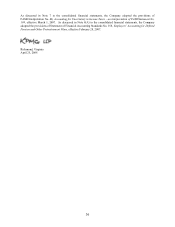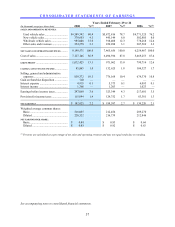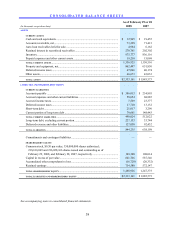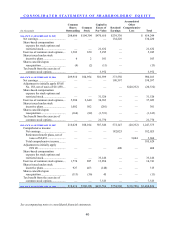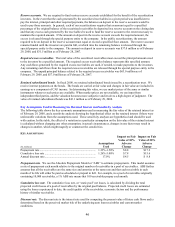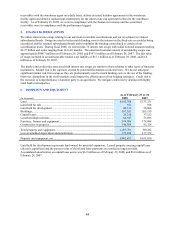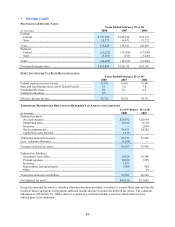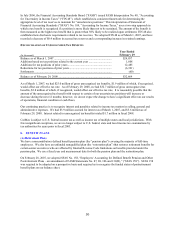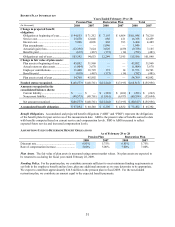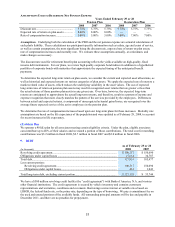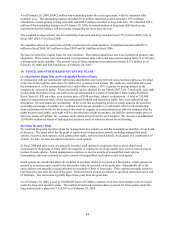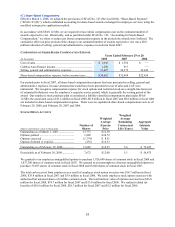CarMax 2008 Annual Report Download - page 58
Download and view the complete annual report
Please find page 58 of the 2008 CarMax annual report below. You can navigate through the pages in the report by either clicking on the pages listed below, or by using the keyword search tool below to find specific information within the annual report.
46
Reserve accounts. We are required to fund various reserve accounts established for the benefit of the securitization
investors. In the event that the cash generated by the securitized receivables in a given period was insufficient to
pay the interest, principal and other required payments, the balances on deposit in the reserve accounts would be
used to pay those amounts. In general, each of our securitizations requires that an amount equal to a specified
percentage of the original balance of the securitized receivables be deposited in a reserve account on the closing date
and that any excess cash generated by the receivables be used to fund the reserve account to the extent necessary to
maintain the required amount. If the amount on deposit in the reserve account exceeds the required amount, the
excess is released through the special purpose entity to the company. In the public securitizations, the amount
required to be on deposit in the reserve account must equal or exceed a specified floor amount. The reserve account
remains funded until the investors are paid in full, at which time the remaining balance is released through the
special purpose entity to the company. The amount on deposit in reserve accounts was $37.0 million as of February
29, 2008, and $31.5 million as of February 28, 2007.
Required excess receivables. The total value of the securitized receivables must exceed the principal amount owed
to the investors by a specified amount. The required excess receivables balance represents this specified amount.
Any cash flows generated by the required excess receivables are used, if needed, to make payments to the investors.
Any remaining cash flows from the required excess receivables are released through the special purpose entity to the
company. The unpaid principal balance related to the required excess receivables was $63.0 million as of
February 29, 2008, and $57.0 million as of February 28, 2007.
Retained subordinated bonds. In fiscal 2008, we retained subordinated bonds issued by a securitization trust. We
receive interest payments on the bonds. The bonds are carried at fair value and changes in fair value are included in
earnings as a component of CAF income. In determining fair value, we use market prices of the same or similar
instruments whenever such prices are available. When market prices are not available, we use input from
independent third parties, and the valuation becomes more subjective and involves a high degree of judgment. The
value of retained subordinated bonds was $43.1 million as of February 29, 2008.
Key Assumptions Used in Measuring the Retained Interest and Sensitivity Analysis
The following table shows the key economic assumptions used in measuring the fair value of the retained interest as
of February 29, 2008, and a sensitivity analysis showing the hypothetical effect on the retained interest if there were
unfavorable variations from the assumptions used. These sensitivity analyses are hypothetical and should be used
with caution. In this table, the effect of a variation in a particular assumption on the fair value of the retained interest
is calculated without changing any other assumption; in actual circumstances, changes in one factor may result in
changes in another, which might magnify or counteract the sensitivities.
KEY ASSUMPTIONS
(In millions)
Assumptions
Used
Impact on Fair
Value of 10%
Adverse
Change
Impact on Fair
Value of 20%
Adverse
Change
Prepayment rate.............................................................................. 1.33%-1.50% $ 8.8 $ 17.2
Cumulative loss rate ....................................................................... 1.26%-3.00% $ 7.8 $ 15.6
Annual discount rate....................................................................... 17.0% $ 4.5 $ 8.8
Prepayment rate. We use the Absolute Prepayment Model or “ABS” to estimate prepayments. This model assumes
a rate of prepayment each month relative to the original number of receivables in a pool of receivables. ABS further
assumes that all the receivables are the same size and amortize at the same rate and that each receivable in each
month of its life will either be paid as scheduled or prepaid in full. For example, in a pool of receivables originally
containing 10,000 receivables, a 1% ABS rate means that 100 receivables prepay each month.
Cumulative loss rate. The cumulative loss rate, or “static pool” net losses, is calculated by dividing the total
projected credit losses of a pool of receivables by the original pool balance. Projected credit losses are estimated
using the losses experienced to date, the credit quality of the receivables, economic factors and the performance
history of similar receivables.
Discount rate. The discount rate is the interest rate used for computing the present value of future cash flows and is
determined based on the perceived market risk of the underlying auto loan receivables and current market
conditions.


